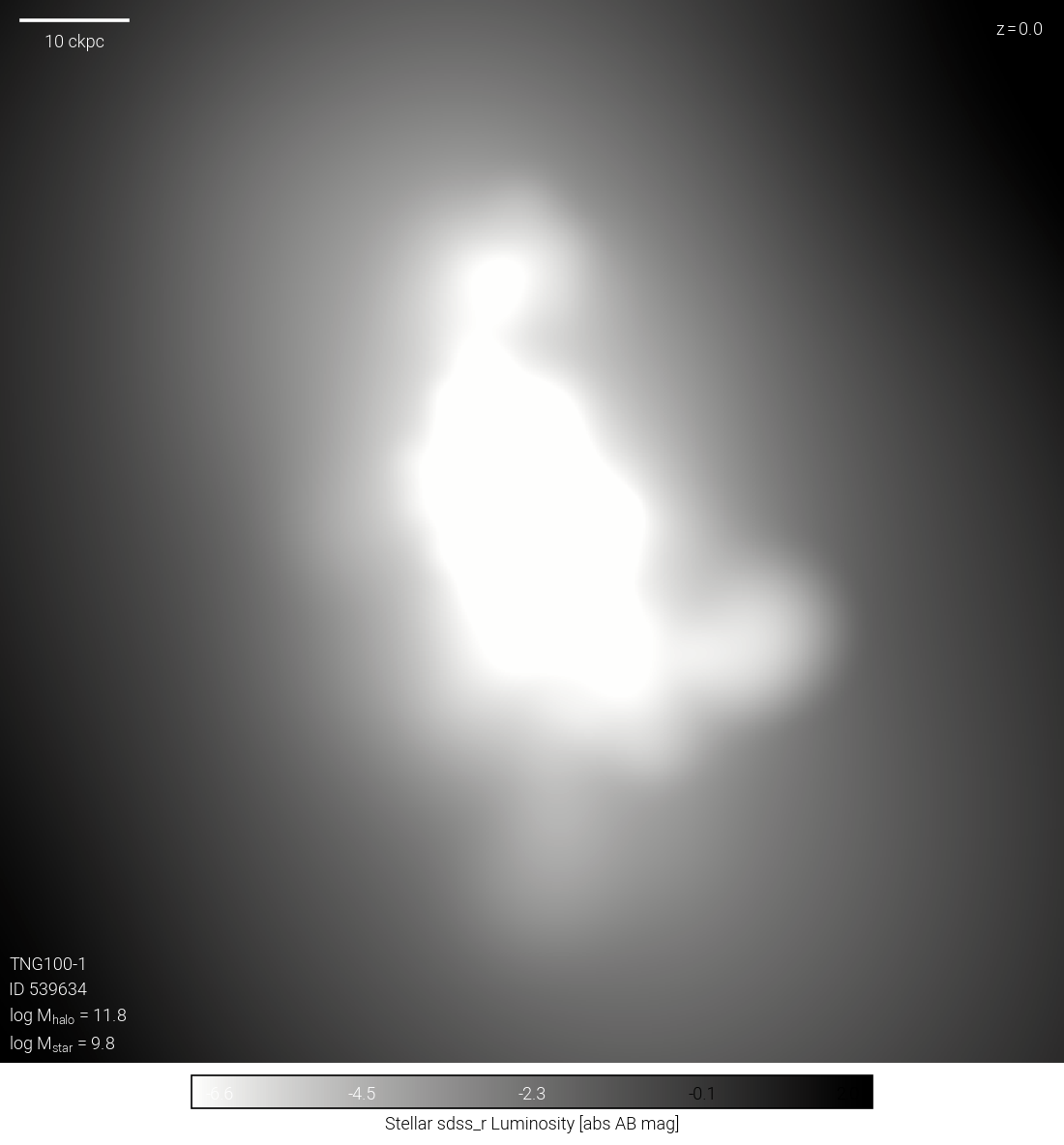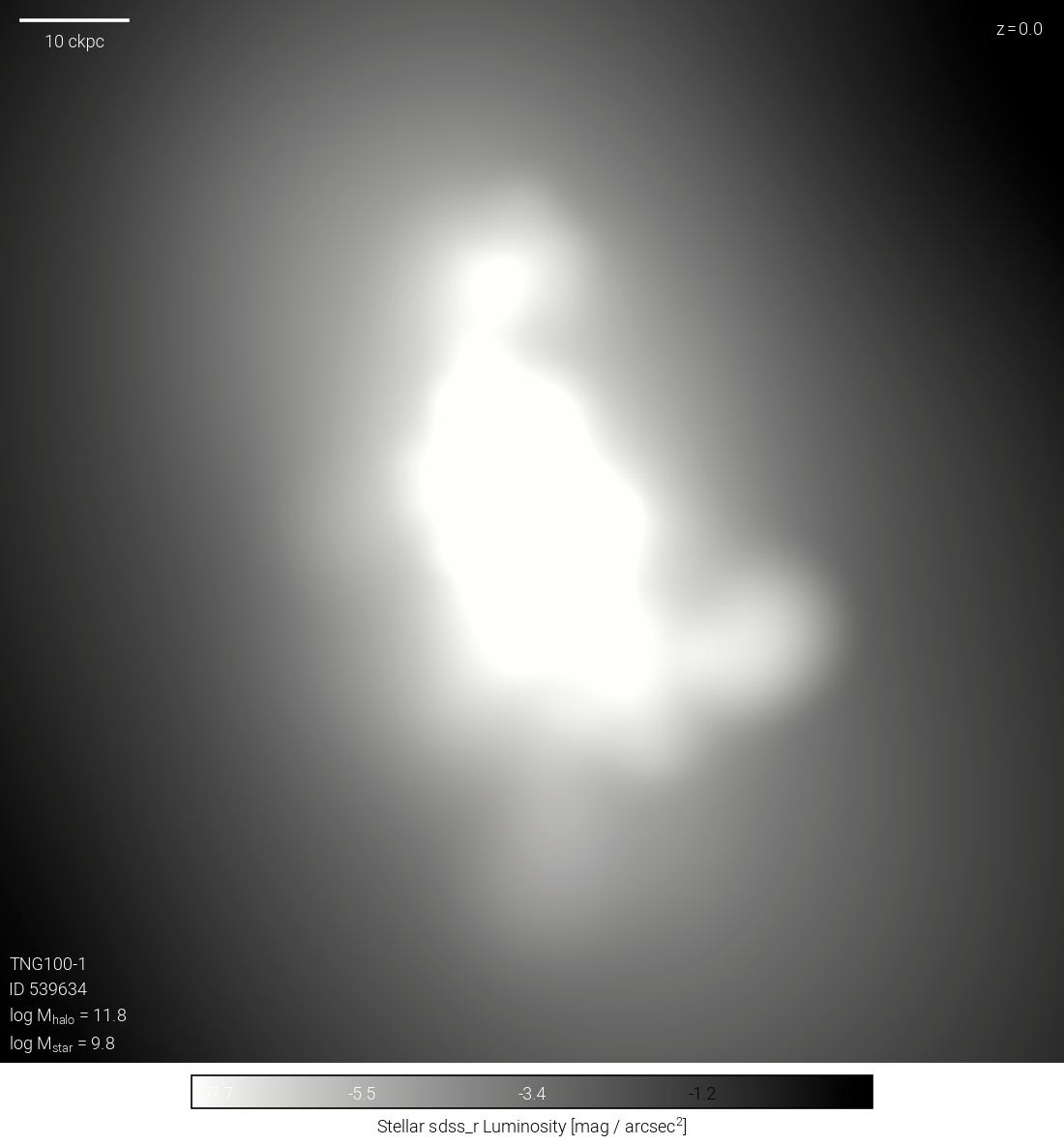Hi,
For the purposes of comparing TNG visualizations with SDSS images: when I use the 'Visualize Galaxies and Halos' tool to create an image of a subhalo with the partField listed as 'stellarBandObsFrame-sdss_,' the intensity scale is given as [mag/arcsec^2]. Is this AB magnitude? Or is it something else like SDSS maggies?
-Mathilda
Dylan Nelson
27 Oct '21
Hi Mathilda,
Yes always AB magnitudes.
Mathilda Avirett-Mackenzie
27 Oct '21
Thanks Dylan, sorry if I missed that stated obviously somewhere.
Mathilda Avirett-Mackenzie
28 Oct '21
Something that's confusing me a lot: the "observed frame" magnitudes for visualizations made like this from snapshots 95-98 seem way too bright to be apparent magnitudes at the luminosity distance of the associated redshift. I'm (at least attempting) attaching examples of a snapshot 99 subhalo viewed in 'stellarBand-sdss_r' which says it's the absolute AB magnitude vs in 'stellarBandObsFrame-sdss_r' where the magnitude scale is brighter than for the absolute magnitude. Looking at a similar subhalo in snapshot 94 the magnitude scale drops to 20s-30s as one would expect for the apparent magnitude of a distant galaxy. Are the magnitudes for these particular snapshots scaled differently somehow?
Dylan Nelson
28 Oct '21
Hi Mathilda,
Keep in mind this tool is meant only for a first look - if you need more fine-grained control over what is going on, you may want to do the (star particles -> light) and (light -> image) conversions yourself.
The stellarBand-* fields should produce an image of absolute AB magnitude, i.e. they collect all the luminosity of stars falling into each pixel, and convert that to magnitudes (in a pixel).
The stellarBandObsFrame-* fields should produce an image of apparent AB magnitude surface brightness, i.e. the units are no longer "abs AB mag" but "apparent AB mag / arcsec^2". This may not be the units you are looking for / comparing against?
With this detail, do the results make sense?
(There is no difference between snapshots 98, 98, 97, 96, 95, 94... except for the slowly changing redshift).
Maybe this example shows it better, this is the same subhalo in snapshots 94 and 95 (to be clear, subhalo 70 in snapshot 94 is the first and only progenitor of subhalo 70 in snapshot 95). Nothing else about the two image requests has changed. The surface brightness changes by many orders of magnitude between the two snapshots.
I think you're right that I should move to making the images from snapshot data myself, but it'd be nice to understand what's going on here. The units make sense for images that are from earlier snapshots than 95 (at least until 80, that's the earliest I've looked).
Thanks for the very clear case - I've found the culprit, a rather unfortunate rounding error, which means in effect that the stellar magnitudes tables would be loaded from a redshift rounded to the nearest dz=0.05. So snapshots 98,97,96,95 were all using z=0 (much too bright), whereas 94 switched to z=0.05.
This would make any ObsFrame* images wrong, to some degree, for snapshots whose redshifts were not divisible by 0.1.
I've made the fix, and removed all old files. Please give it a check and let me know if things seem better. Many thanks for the bug report!
p.s. you likely know, but in general subhalos don't keep their ID between snapshots, it is just extreme coincidence that subhalo 70 of snapshot 95 is also subhalo 70 in snapshot 94
Mathilda Avirett-Mackenzie
28 Oct '21
Hi Dylan,
Checking a few subhalos it looks much more reasonable now, yes. Thanks!
p.s. I hadn't given it much thought until about an hour ago, hence my edit :)
Hi,,' the intensity scale is given as [mag/arcsec^2]. Is this AB magnitude? Or is it something else like SDSS maggies?
For the purposes of comparing TNG visualizations with SDSS images: when I use the 'Visualize Galaxies and Halos' tool to create an image of a subhalo with the partField listed as 'stellarBandObsFrame-sdss_
-Mathilda
Hi Mathilda,
Yes always AB magnitudes.
Thanks Dylan, sorry if I missed that stated obviously somewhere.
Something that's confusing me a lot: the "observed frame" magnitudes for visualizations made like this from snapshots 95-98 seem way too bright to be apparent magnitudes at the luminosity distance of the associated redshift. I'm (at least attempting) attaching examples of a snapshot 99 subhalo viewed in 'stellarBand-sdss_r' which says it's the absolute AB magnitude vs in 'stellarBandObsFrame-sdss_r' where the magnitude scale is brighter than for the absolute magnitude. Looking at a similar subhalo in snapshot 94 the magnitude scale drops to 20s-30s as one would expect for the apparent magnitude of a distant galaxy. Are the magnitudes for these particular snapshots scaled differently somehow?


Hi Mathilda,
Keep in mind this tool is meant only for a first look - if you need more fine-grained control over what is going on, you may want to do the (star particles -> light) and (light -> image) conversions yourself.
The
stellarBand-*fields should produce an image of absolute AB magnitude, i.e. they collect all the luminosity of stars falling into each pixel, and convert that to magnitudes (in a pixel).The
stellarBandObsFrame-*fields should produce an image of apparent AB magnitude surface brightness, i.e. the units are no longer "abs AB mag" but "apparent AB mag / arcsec^2". This may not be the units you are looking for / comparing against?With this detail, do the results make sense?
(There is no difference between snapshots 98, 98, 97, 96, 95, 94... except for the slowly changing redshift).
Hi Dylan,
Maybe this example shows it better, this is the same subhalo in snapshots 94 and 95 (to be clear, subhalo 70 in snapshot 94 is the first and only progenitor of subhalo 70 in snapshot 95). Nothing else about the two image requests has changed. The surface brightness changes by many orders of magnitude between the two snapshots.
I think you're right that I should move to making the images from snapshot data myself, but it'd be nice to understand what's going on here. The units make sense for images that are from earlier snapshots than 95 (at least until 80, that's the earliest I've looked).
Hi Mathilda,
Thanks for the very clear case - I've found the culprit, a rather unfortunate rounding error, which means in effect that the stellar magnitudes tables would be loaded from a redshift rounded to the nearest dz=0.05. So snapshots 98,97,96,95 were all using z=0 (much too bright), whereas 94 switched to z=0.05.
This would make any
ObsFrame*images wrong, to some degree, for snapshots whose redshifts were not divisible by 0.1.I've made the fix, and removed all old files. Please give it a check and let me know if things seem better. Many thanks for the bug report!
p.s. you likely know, but in general subhalos don't keep their ID between snapshots, it is just extreme coincidence that subhalo 70 of snapshot 95 is also subhalo 70 in snapshot 94
Hi Dylan,
Checking a few subhalos it looks much more reasonable now, yes. Thanks!
p.s. I hadn't given it much thought until about an hour ago, hence my edit :)